Talk of North Indian cuisine, and it will never get completed without the mention of the classic combination of Rajma Chawal. Which is basically a robust Kidney Beans Curry paired with the good ol’ fluffy steamed rice. Here, I have shared a one-pot recipe of Rajma that is made entirely in a stovetop pressure cooker. It is really easy to make, if you have all the ingredients ready. Many of these ingredients are also easily available in an Indian kitchen.
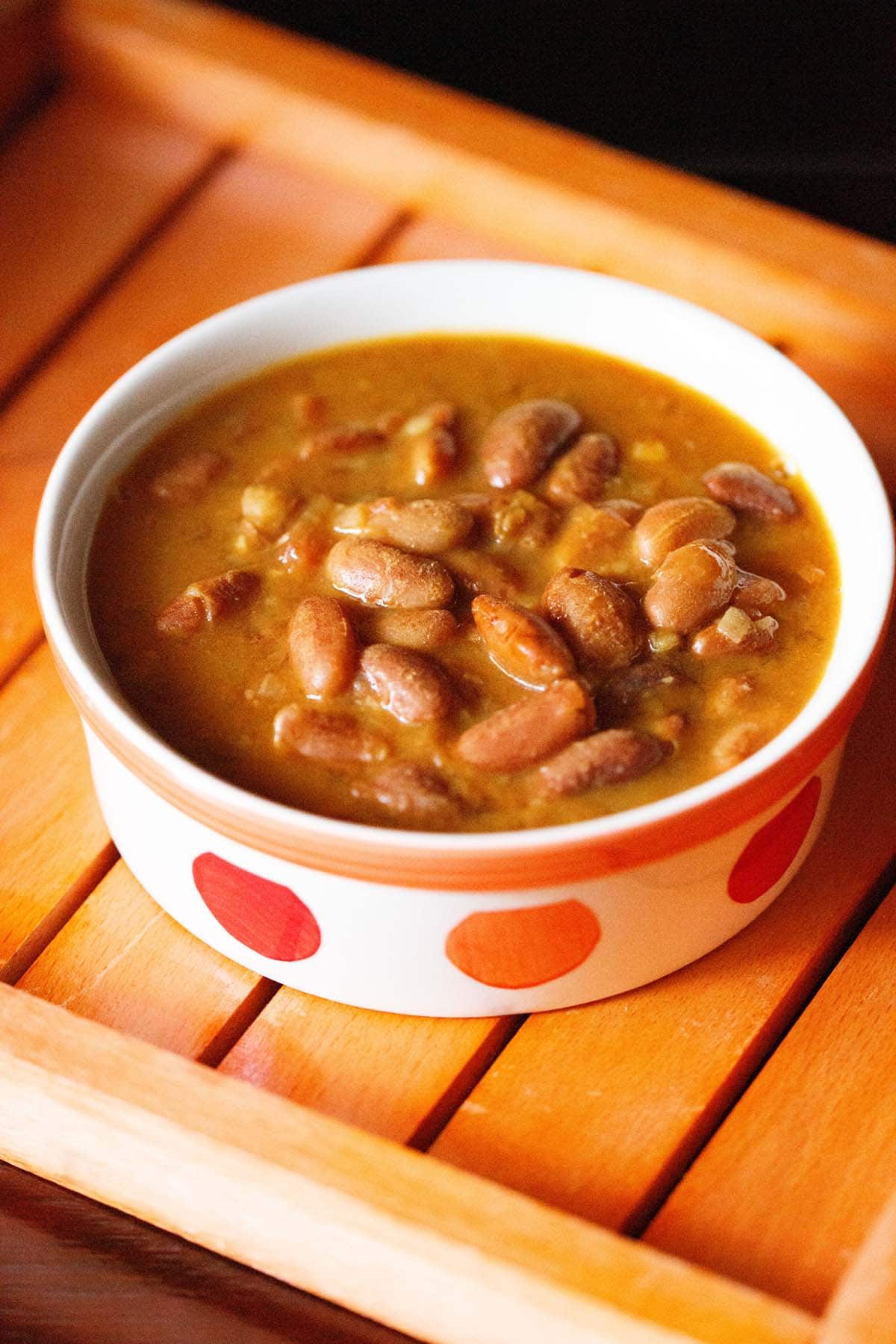
Why You Will Love This Rajma Chawal
Rajma Chawal is super common in any or all Punjabi households. Not just Punjab, it is also a much-loved dish in Himachal Pradesh and Jammu in Northern India. You can also check this Himachali-style Rajma Madra Recipe made without onion and garlic.
On weekends, Rajma Chawal or Dal Makhani or Chole Recipe or Kadhi Pakora is kind of a must in my home.
As I mentioned in the beginning, the literal translation of Rajma Chawal is a ‘flavorful curry made of kidney beans (rajma)’ served with ‘steamed rice (chawal).’
On this post, I have shared both the methods of making the delicious kidney bean curry and steamed rice with step-by-step pictures. I have also shared a restaurant-style version of Rajma Recipe on the blog.
Table of Contents
This easy one-pot rajma curry is my mother-in-law’s fabulous recipe. It is really a special recipe because it is really unique, simple and easy to prepare.
No blending or grinding of any ingredients, no sautéing and no frying as well. Can easily be made regularly at home.
The most quintessential pairing is that of a Rajma Chawal, which is loved by one and all. But at home, we also enjoy this spiced kidney bean curry with chapati or paratha or Naan or bread. It also goes really great with Jeera Rice.

Things to keep in mind
The Rajma Chawal that you will find in typical Punjabi homes is not spicy, thick or creamy like the rajma served in restaurants. Hence, my homestyle recipe is also mildly spiced and not heavy as I do not add any cream.
In most households, the kidney beans are cooked till they become soft enough to melt in the mouth.
Whereas in many of the restaurants I have had it, the beans are just about cooked or al dente. I recommend cooking the kidney beans fully so that they become soft and easy to digest.
Another important point which I must mention about when cooking with kidney beans is to soak the beans overnight so that they take less time to cook in the pressure cooker. Soaking also makes them easy to digest as it reduces the phytic acid from the beans.
Lets Begin With Rajma Chawal Recipe
First you need to make the curry with the kidney beans. I always use dried kidney beans to make this recipe.
Dried kidney beans need to be soaked for a good amount of hours, before cooking with them.
Soak Kidney Beans & Preparation
1. Soak 1 cup kidney beans in enough water for 8 to 9 hours or overnight.
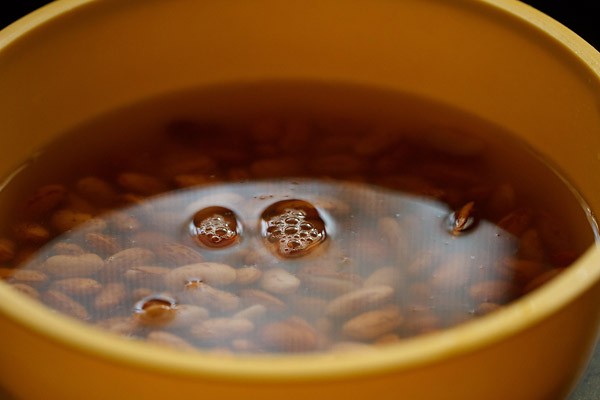
2. The next day or after 8 to 9 hours, drain the soaked water.

3. Rinse the kidney beans again in fresh clean water.
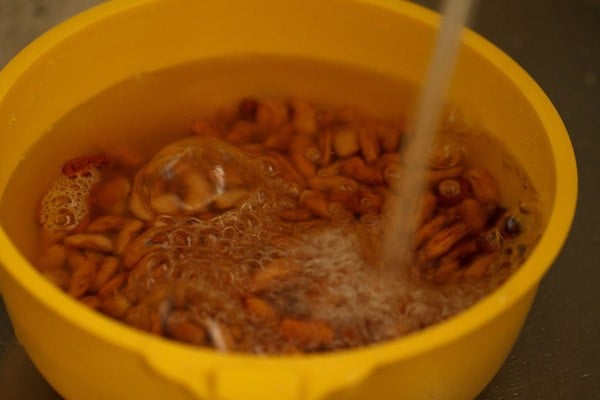
4. Drain all the water and keep the kidney beans aside.
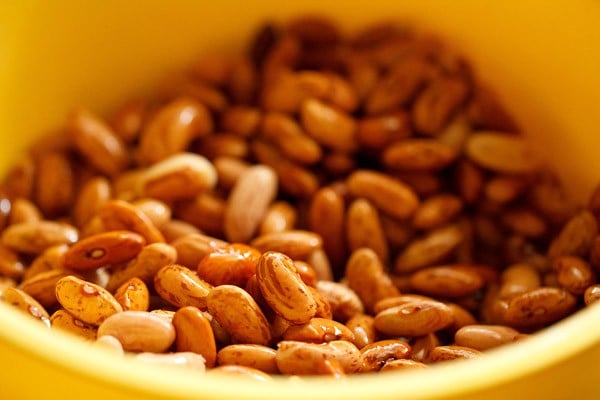
5. Finely chop the vegetables – 1 large onion, 3 medium tomatoes, 1 inch ginger, 7 to 8 medium garlic cloves and 1 green chili. Keep aside.
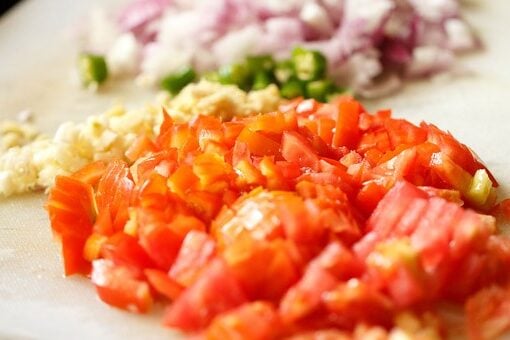
Cook Rajma
6. In a 3-liter stovetop pressure cooker, add the kidney beans together with the chopped onions, tomatoes, ginger, garlic and green chilies.

7. Add 1 teaspoon cumin seeds, ½ teaspoon red chili powder, ½ teaspoon turmeric powder and salt as per taste.

8. Pour 2½ cups water.
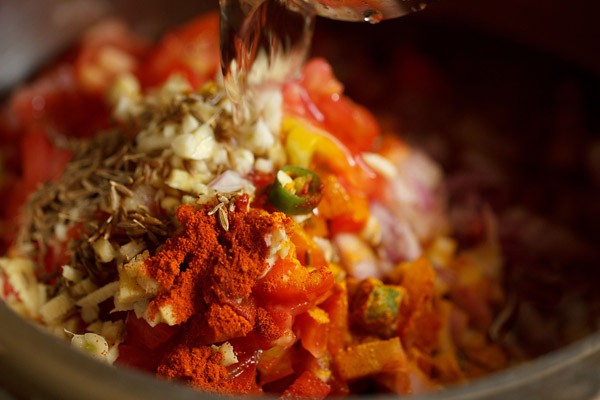
9. Stir and mix very well.
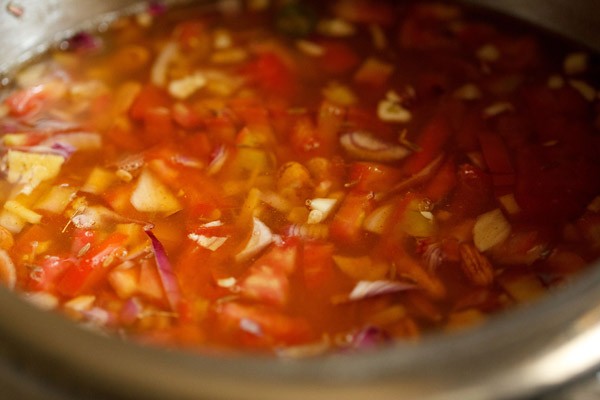
10. Add 2 tablespoons butter or oil.
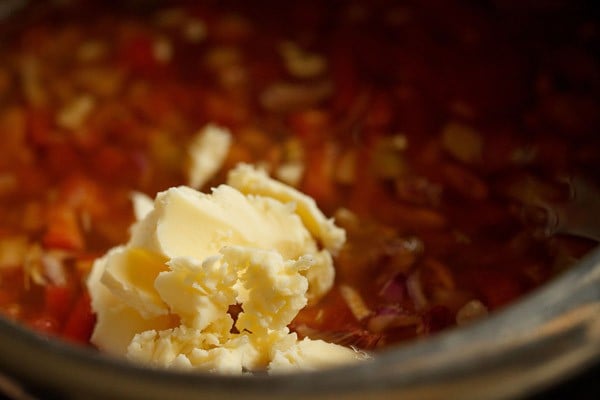
11. Stir again.
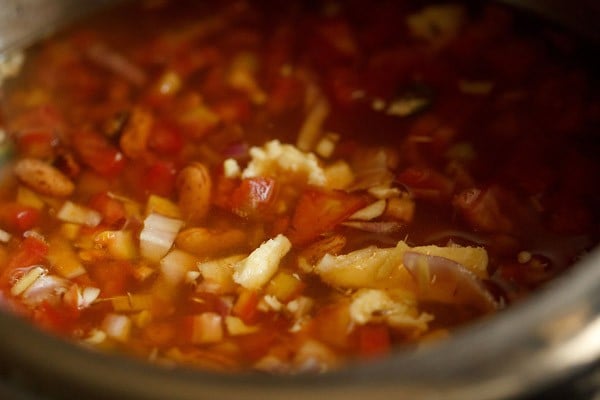
12. Seal and cover the pressure cooker tightly with its lid and pressure cook on medium-high to high heat for 18 to 20 whistles or about 20 to 22 minutes.

13. Once the pressure drops naturally on its own, then only open the lid and check the beans. The kidney beans have to be soft and cooked completely.
Taste a few beans and they should melt in the mouth without giving you any bite or resistance while eating.
If the beans are still not cooked completely, then add about ½ cup more of water and pressure cook again for 5 to 6 whistles or as needed.

Simmer Rajma Further
14. Once the kidney beans have softened and are cooked well, check the consistency of the gravy or curry.
You will see a thin water-like stock with the tomatoes and onions floating. So you have to continue to simmer till the gravy thickens a bit.
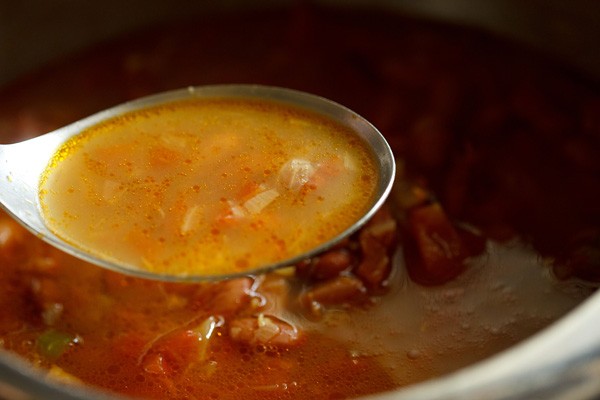
15. Keep the cooker on the stovetop without lid and on medium-low to medium heat and simmer the gravy.
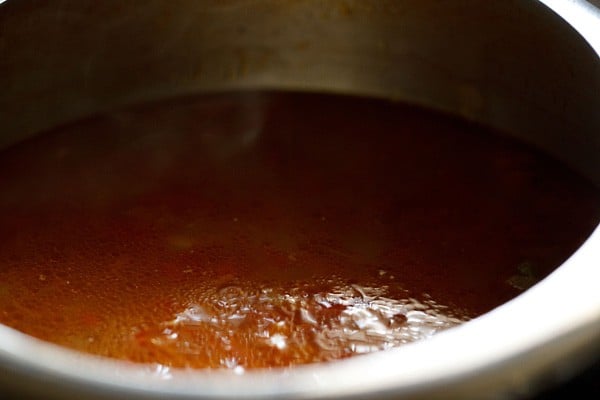
16. When you keep the rajma gravy on the stovetop, add 1 teaspoon dried mango powder.
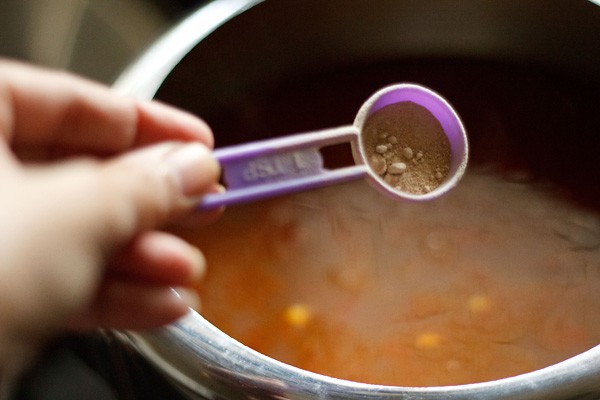
17. Add about ¾ to 1 teaspoon garam masala powder.
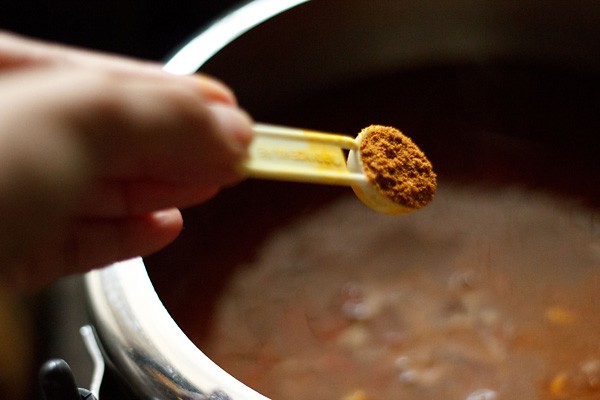
18. Mix well and simmer till the gravy thickens. Mash a few kidney beans with the back of a spoon to thicken the consistency.
If while cooking, the water reduces too much and the consistency becomes very thick, add some hot water and stir to combine.

19. When the consistency of the gravy is no longer broth-like or water-like and thickened somewhat like the one shown in the picture below, then the rajma gravy is ready. If you want you can thicken the gravy more, if having with chapati or roti.
But if eating rajma with rice then there is no need to thicken the gravy too much.
Lastly, check the taste and add more of salt, garam masala powder or dried mango powder, if required. You can even garnish the curry with some coriander leaves.
Remember that the curry consistency is not watery but smooth. If you find that the water is too much after the beans are cooked, then cook the gravy for some more time without any lid to evaporate the water.
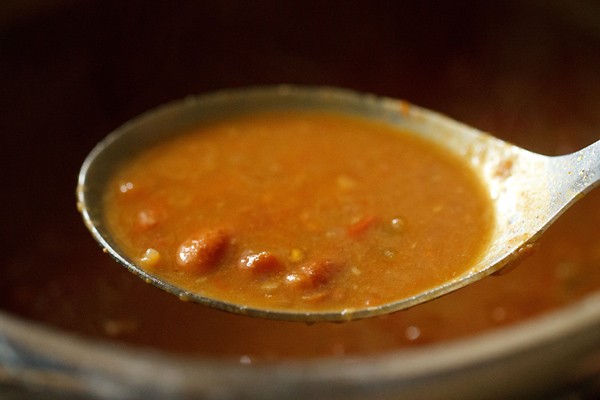
How to make Chawal (Steamed Rice)
I am sharing the absorption method of cooking rice. You can take the quantity of rice that you plan to serve. I have here taken 1 heaped cup basmati rice (200 grams).
You can easily double or triple the ingredients to make a larger serving of the rice to suit your servings of Rajma Chawal.
Note: Basmati rice triples in volume once cooked. So 1 cup raw basmati rice will yield approximately 3 to 3½ cups of cooked rice.
Soak Rice
1. Take 1 cup of basmati rice in a bowl and begin to rinse the rice grains in running water.
Rinse the grains with a gentle swirling of your fingers in the bowl. Rinse the rice grains until the water looks clear of any starch.

2. Soak the rice grains in ¾ to 1 cup water for 20 to 30 minutes. After keeping the kidney beans to cook in the pressure cooker, you can begin with the rinsing and soaking of rice.
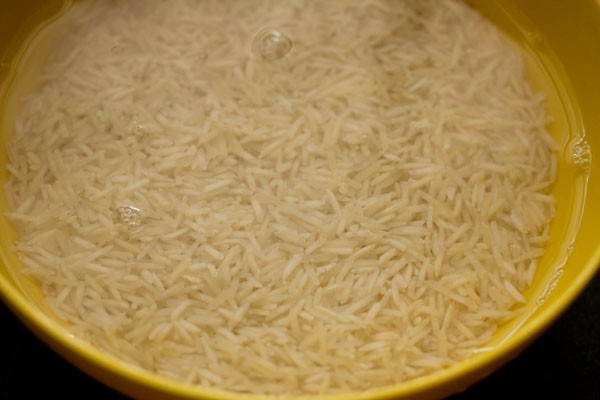
3. After 20 to 30 minutes, drain all the water from the rice and keep it aside.
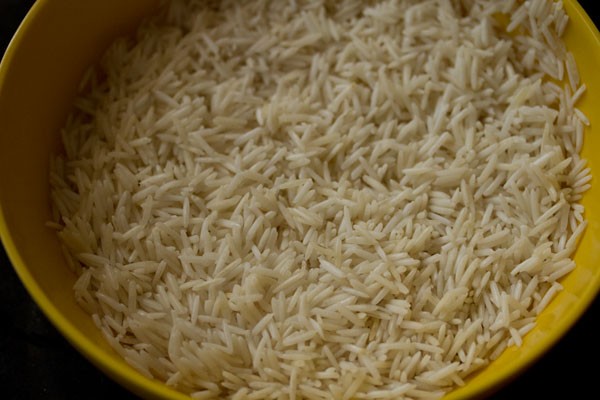
Cook Rice
4. For 1 cup of rice, pour 2 cups water in a heavy thick-bottomed pan. Use the proportion of 1:2 of rice and water depending on the quantity of rice you are using.
Also, use a wide deep pan so that the water does spill out while cooking. The quantity of water to be added depends on the quality and quantity of rice.
Note: Some varieties of basmati rice gets cooked quickly in less water. In this case, you can add 1½ to 1¾ cups of water for 1 cup of rice.

6. Add ¼ teaspoon salt or as per your taste. You can also add ½ teaspoon of oil or butter or ghee. Adding any fat like oil or butter is optional.

7. Let the water come to a boil on a medium to medium-high heat.
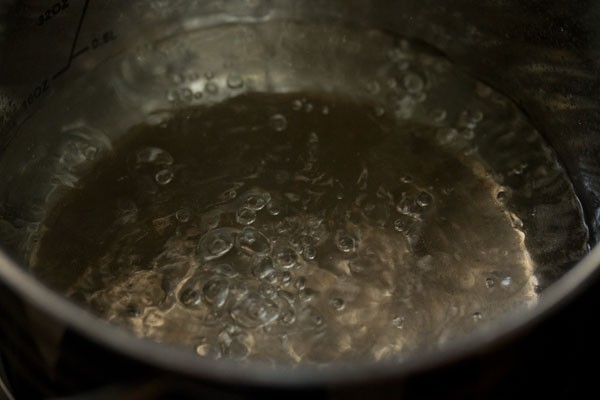
8. Add the rice.

9. Gently stir the rice grains with a fork. You can even gently shake the pan, so that the rice grains settle down in the pan.

10. Cover the pan with a tight-fitting lid. Check once or twice when the rice is cooking.
In case the rice grains look undercooked and the water has dried up, add 2 to 3 tablespoons hot water. Stir gently with a fork.

11. Then, lower the heat and cook the rice until all the water has been absorbed and the rice grains are tender and have cooked well.
Usually, rice takes about 7 to 8 minutes for the rice grains to be tender, soft and fluffy.
The cooking time will vary with the type or variety of rice grains, quality of the pan and the intensity of the heat.

12. After the rice is cooked give a resting time of 5 minutes before you open the lid. Then, open the lid and gently fluff the rice with a fork.
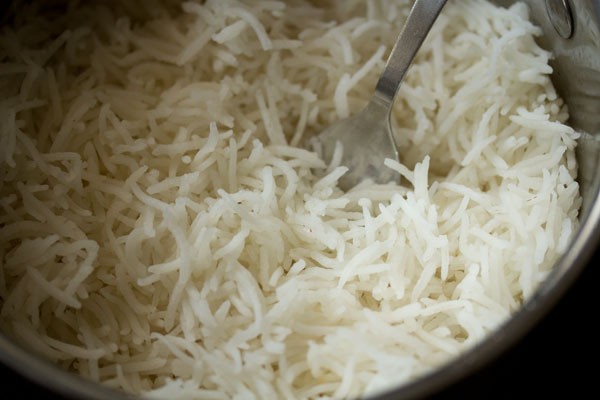
Serve Rajma Chawal
13. To serve Rajma Chawal, first spoon hot steamed rice onto a serving plate. Make a neat bed of the rice. Pour the rajma gravy on top of the rice.
Enjoy Rajma Chawal and don’t forget to include sides of some thinly sliced onions, lemon wedges or spice up with a simple kachumber salad or mango pickle.
Rajma curry can also be served with roti or paratha or naan or bread. But this combination of kidney beans curry with rajma or Rajma Chawal is very popular in Western and Northern India.
Though we prefer cooking white basmati rice for our Rajma Chawal dinners. But feel free to serve the curry with brown rice or red rice or hand-pounded rice. You can opt to use any other variety of white rice to make it.
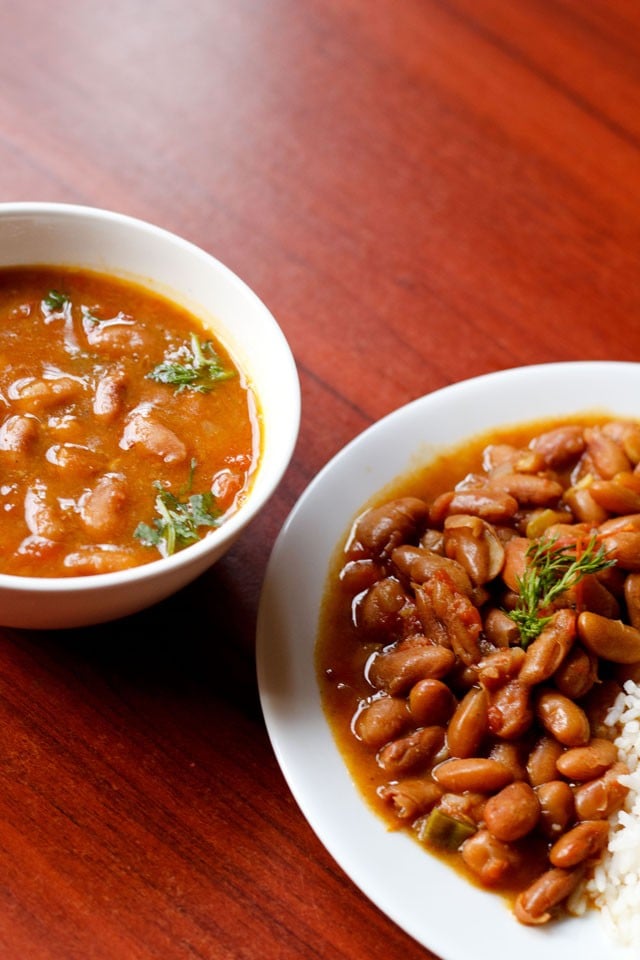
Expert Tips
- Soaking kidney beans: Rinse the kidney beans thoroughly and soak in enough water for 8 to 9 hours or preferably overnight. This helps in softening the beans and reduces cooking time. It also makes the beans more digestible.
- Choice of fat: You can use butter or oil or ghee in this recipe.
- Adjusting consistency: If the gravy is too thick, add more water and adjust the consistency as per your likings. Don’t forget to simmer for some more time after adding more water.
- Finishing touch: Finish off the rajma curry by sprinkling some crushed dried fenugreek leaves (kasuri methi) for an added aroma. You can also garnish with freshly chopped coriander leaves.
- Scalability: This recipe serves 4 and you can easily halve or double the ingredients to make for less or more servings.
More North Indian Recipes To Try!
Dal (Lentils) & Legumes
Chickpea Recipes
Vegan Recipes
Chickpea Recipes
Please be sure to rate the recipe in the recipe card or leave a comment below if you have made it. For more vegetarian inspirations, Sign Up for my emails or follow me on Instagram, Youtube, Facebook, Pinterest or Twitter.

Rajma Chawal Recipe (Easy One Pot)
Ingredients
For pressure cooking kidney beans
- 1 cup rajma (dried kidney beans), 200 grams – soaked overnight in enough water
- 2.5 cups water – for pressure cooking
Other ingredients
- ½ to 1 teaspoon green chili – chopped or 1 to 2 green chillies
- 1 tablespoon garlic – finely chopped or 7 to 8 medium-sized peeled garlic
- 1 tablespoon ginger – finely chopped or 1 inch peeled & chopped ginger
- 3 tomatoes – medium-sized, finely chopped; 200 grams
- 1 onion – large, finely chopped; 100 grams
- ½ teaspoon turmeric powder
- ½ teaspoon red chili powder
- ¾ to 1 teaspoon Garam Masala
- 1 teaspoon dry mango powder (amchur powder)
- 1 teaspoon cumin seeds
- 2 tablespoon Butter or oil
- salt as required
For cooking basmati rice (chawal)
- 1 cup basmati rice (heaped), 200 grams
- 2 cups water or add as required depending on the quality of rice
- ½ teaspoon oil (optional)
- ¼ teaspoon salt or add as per taste
Instructions
Preparation
- Rinse the kidney beans for a couple of times in running water.
- Then soak the beans in enough water overnight or for 8 to 9 hours.
- The next day or after 8 to 9 hours, drain the soaked water.
- Rinse the beans again in fresh clean water. Drain all the water and keep the soaked beans aside.
- Chop the veggies – onion, tomatoes, ginger, garlic and green chilies. Set aside.
Making rajma
- In a pressure cooker add the kidney beans along with the chopped onions, tomatoes, ginger, garlic and green chilies
- Now add the spices – cumin seeds, red chili powder, turmeric powder and salt.
- Pour water. Stir and mix very well.
- Add butter or oil. Stir again.
- Cover and seal tightly with lid and pressure cook for 18 to 20 whistles on a high heat.
- Once the pressure drop naturally in the cooker, then only open the lid and check the beans. The kidney beans have to be cooked completely.
- Taste a few kidney beans and they should be melt in the mouth without giving you any bite or resistance while eating.
- If the beans are still not cooked completely, then add about ½ cup more of water and pressure cook again for 5 to 6 whistles.
- Once the beans are cooked well, then check the gravy also, you will see a thin water-like stock with the tomatoes and onions floating.
- So you have to continue to simmer till the gravy thickens a bit.
- Keep the cooker on stovetop and on a medium-low to medium heat, simmer without lid. Stir at intervals.
- When you keep the rajma curry on the stovetop, then add the dry mango powder garam masala powder.
- Stir well and simmer the curry till the consistency thickens. Mash a few kidney beans with the back of a spoon to thicken the consistency.
- When the consistency of the gravy is no longer broth-like or water-like and thickened. Then the rajma curry is ready.
- If you want you can thicken the gravy more if having with chapati or phulka or roti.
- Lastly check the taste and add more of salt, garam masala, red chili powder or dry mango powder if required.
- Garnishing with coriander leaves is optional. Serve rajma with some steamed rice or with chapati, paratha or naan. You can also serve with cumin rice or saffron rice.
- Although you can serve rajma with any medium or short-grain variety of rice but it tastes best with basmati rice.
Making chawal or cooking basmati rice
- Take the amount of rice that you plan to serve. I have taken 1 cup heaped basmati rice (200 grams).
- Take the rice in a bowl and begin to rinse the rice grains in running water till the water is clear of starch
- Soak the rice grains in ¾ to 1 cup water for 20 to 30 minutes. After keeping the kidney beans to cook in the pressure cooker, you can begin with the rinsing and soaking of rice.
- Later drain all the water from the rice and set aside
- For 1 cup of rice, pour 2 cups water (500 ml) in a heavy thick deep bottomed pan. Use the proportion of 1:2 of rice and water depending on the quantity of rice you are using. Also, use a wide deep pan so that the water does spill out while cooking.
- Note that the amount of water to be added depends on the quality and quantity of rice. Sometimes some strains of basmati rice get cooked quickly in less water. In this case, you can add 1½ to 1¾ cups of water for 1 cup of rice.
- Add ¼ teaspoon salt or as per your taste. You can also add ½ teaspoon oil or butter or ghee. Adding any fat like oil or butter is optional.
- Let the water come to a boil on a medium to medium-high heat.
- Then add the rice and gently stir with a fork.
- Cover the pan with a tight-fitting lid. Do check once or twice when the rice is cooking.
- In case the rice grains look undercooked and the water has dried up, then add 2 to 3 tablespoons hot water. Stir gently with a fork then lower the flame and cook the rice till all the water has been absorbed and the rice grains have cooked well.
- Usually, rice takes about 7 to 8 minutes for the rice grains to be tender, soft and fluffy. However keep in mind that the cooking time will vary with the type or variety of rice grains, quality of the pan and the intensity of the heat.
- After the rice is cooked give a resting time of 5 minutes before you open the lid. Then open the lid and gently fluff the rice with a fork. For a detailed step by step method of making basmati rice you can check this post – How to cook basmati rice in a pot or pan.
- While serving, spoon the rice in a serving plate. Pour the rajma gravy on top of the rice. Serve with a side of some chopped lemons, sliced onions and/or chopped tomatoes. Enjoy Rajma Chawal.
Notes
- First soak the rajma as usual for 8 to 9 hours.
- Drain them and rinse them with fresh water.
- Then in a huge pot, boil enough water first.
- Add the rajma and salt.
- Cook covered for about 45 to 1 hour or more if required.
- It takes a long time to cook rajma without a pressure cooker.
Nutrition Info (Approximate Values)
This Rajma Chawal recipe from the archives was first published in October 2011. It has been updated and republished on May 2024.




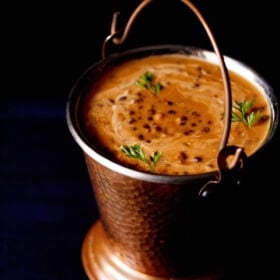
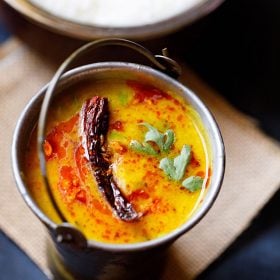

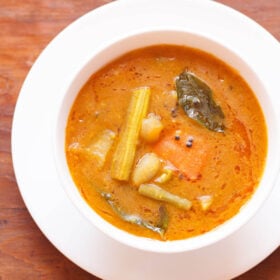








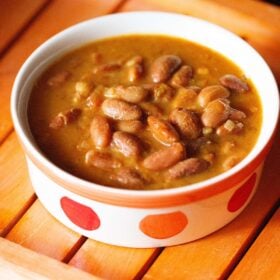
Excellent guidance by Mrs Dassana Amit.
Thank you.
One of the easiest rajma recipes. And yet so tasty. Big fan of yours since many years Dassana Amit! Yours recipes are my go-to whenever needed in ‘vegetarian’
Thanks so much Prema. So glad to read your comment. Happy Cooking.
Excellent recipe -turned out great. Thank you.
Lovely and thanks for sharing the feedback and the rating.